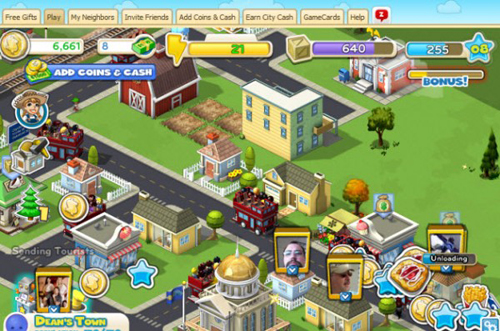盘点社交游戏5个必不可少的成功“窍门”
作者:Nadia Oxford
社交游戏领域究竟有多火热?美国市场研究调查机构Parks Associates最近的一项报告表示,按照社交游戏如此高的人气,到2015年它所带来的收益将翻五倍。
Parks Associates研究分析师Pietro Macchiarella称,“社交游戏已经成为网页游戏中发展最突出的一类游戏。如今,每个月共有2亿5000多万玩家登陆Facebook玩Zynga的《CityVille》和《FarmVille》等游戏,而游戏开发商和市场营销者也都注意到了这火热的局面。”
来自EA的例子将能够很好地描述社交游戏是如何强有力的推动整个游戏产业的发展。EA收购了新兴社交游戏开发商Playfish,以抗衡《FarmVille》开发商——Zynga。
EA总裁Peter Moore表示,“虽然有一个劲敌挡在了我们的前面,但是我们并未落后很远,而且我们有自信能够很快地追上它。很显然,我们现在能做的就是为这个市场创造出更多更高质量的原创游戏。”
这是一个“疯狂的”市场,但是社交游戏的营收是否真的就能够在短短几年内获得5倍的增长呢?实际上,这么说也并不是没有道理。如今,甚至是那些居住在美国农村的电脑盲阿姨们也都热衷于在Facebook上与朋友和亲戚交流。作为社交游戏的潜在玩家,Facebook的基础用户与日俱增,同时,现在也并未出现任何能够取代Facebook现在的地位强劲对手。
虽然如此,不是所有社交游戏都能轻易获得成功的。这是一个充满竞争的领域,在这里已经汇聚了很多玩家在抱怨着市场上过于饱和且无趣的游戏了。以下将列出五点“窍门”,以帮助那些想要在这个热门市场里生存并获取利益的游戏开发商们。
现实世界的品牌化和联合促销:网娃(Webkinz)是社交游戏的第一个成功案例。网娃是一些拥有密码标签的填充玩具。通过密码,孩子们可以进入一个安全和有趣的社交网络。这虽然是一个凸显社交游戏的好方法,但是却甚少有家长愿意预先支付现金让他们的孩子们玩这款社交游戏。当然了,玩具本身就能够很好地调动孩子们的兴趣,另外一款社交游戏——尼奥宠物(NeoPets)发行时就宣称他们将同步发行一些生动形象的尼奥宠物玩具以宣传他们所创造的色彩缤纷的网络世界。
相关的交叉推广:同样道理,与商店同步进行交互推广也能够帮助更好地宣传相关游戏。Pietro Macchiarella认为,“像麦当劳和7-11这些大品牌和如今的很多社交游戏一样,也在执行商品的交叉推广。而且社交游戏通过微交易带来盈利,与药店和杂货店通过贩卖充值卡刺激销售的性质是类似的,通过在收银机旁边贩卖充值卡,商家能够进一步刺激商品的销售。”
简化游戏操作,并以此激励玩家:游戏开发商也该偶尔考虑下用那些需要拿钱去购买的游戏虚拟货币来奖励玩家。“Horseshoes”,“dubloons”和“stars”这些在不同游戏中使用的虚拟货币都是激励玩家在游戏中取得更好成绩的奖励。铁杆游戏玩家(游戏邦注:即积极购买虚拟货币以换取所需的游戏道具的玩家)与轻度游戏玩家有着显著的差别。通过免费提供虚拟货币能够很有效地留住很多玩家。而如果一款游戏在刚开始就让玩家陷入难以突破的困境,玩家们将很快失去对这款游戏的耐心。
按照分析和测试开发和调整游戏:Zynga首席游戏设计师Brian Reynolds在社交游戏中设计并调整快速设计成型的游戏这方面享有很大的发言权。3月份在接受IndustryGamers.com的采访时Reynold表示,“Zynga做了很多相关测试。在《FrontierVille》的测试中,当玩家开始进行游戏的时候我们给予他们10个horseshoes,以此作为一个测试。这时我们就会思考‘如果给玩家15个horseshoes’情况会不会就不一样呢?也许玩家会因为这15个horseshoes而能在游戏中度过困难,建造起属于自己的小屋,而经过观察,我们还发现这些完成小屋建设的玩家会因此保留对该游戏的热爱,成为回访频率较高的老主顾。所以我们就如此执行了。这样做同时也能够为玩家创造更多的游戏乐趣。如果在游戏一开始就设有重重关卡让玩家举步维艰,那么玩家将会远远地逃离这款游戏吧。我们希望能让玩家能够开心地完成游戏中的任务并期待着接下去新的挑战的来临,这是我们能为玩家所做到的最简单的安排。”
广告和创新:最后,根据Pietro Macchiarella所述,正是拥有属于自己的创新型广告,那些迄今最成功的社交游戏才能突破重重竞争,获得如此显赫的成绩。Pietro认为,“游戏发行商必须加强对广告的创新设计,例如对品牌广告,赞助项目,社区活动和娱乐广告注入浓厚的创新精神,而不是盲目地对其进行干预,将能够更好地吸收游戏玩家,并为他们创造出更多的商业利润。”(本文为游戏邦/gamerboom.com编译,转载请注明来源:游戏邦)
Five Tips for Social Game Success
By Nadia Oxford
Social games are really popular (“How popular are they?”). They’re so popular that a report recently released by Parks Associates predicts that revenues from social games will quintuple by 2015.
“Gaming on social networks has quickly become the most visible category of online games,” said Pietro Macchiarella, a Research Analyst with Parks Associates. “Right now more than 250 million people play games like Zynga’s CityVille and FarmVille on Facebook every month, and both game developers and marketers have taken notice.”
If you need a clearer picture of social gaming’s rhinoceros-strength push into the games industry, consider EA’s purchase of the social games start-up, Playfish, and its drive to overcome the proprietor of FarmVille, Zynga.
“There’s a big dog in front of us, but we aren’t far behind, and we’re confident that we can catch up,” EA President Peter Moore said in his MI6 keynote address. “What we can bring to the market in terms of blue chip IP is phenomenal.”
It’s a frenzied market all right, but can we really expect revenues from social games to increase fivefold in a mere few years? It’s not too farfetched; after all, even the most computer-illiterate Aunties in rural America are discovering that Facebook is a wonderful way to keep in touch with her friends and relatives. As Facebook’s user base keeps increasing–and currently, there’s no immediate reason to believe that Facebook will be utterly usurped by a competitor–so will the potential player base for social games.
But social gaming won’t automatically cruise to success. It’s a competitive field, one that’s already garnering player complaints about oversaturation and poor games. Here are five quick tips that might help future social projects get noticed (and therefore attract revenue) in a busy marketplace.
Real-World Branding and Tie-Ins: One of social gaming’s first success stories is Webkinz, a game that combined stuffed toys with a digital online world. Kids buy a Webkinz critter, which comes with an online code that gains them access to a virtual version of their pet in the “Webkinz World.” It’s an interesting way to make a social game stand out, though parents probably aren’t enthusiastic about the idea of ponying cash up-front for access to a social game. Of course, a toy line by itself also helps spark kids’ interest in a social game: NeoPets, another social gaming oldie, boasts a pretty substantial line of licensed accessories that compliments its colorful online world.
Relevant Cross-Promotions: In the same vein, cross-promotions with stores can help boost a game’s presence, too. “Big brands such as McDonald’s and 7-Eleven have carried out cross-promotions with existing social games,” Pietro Macchiarella noted when he listed the reasons for social gaming’s skyrocketing success. Moreover, social games that bring in revenue through microtransactions (that is to say, all of them) sometimes sell point cards in drug stores and grocery stores, often as an impulse item near the cash register.
Make Games Accessible and Incentivize Players: Every so often, consider rewarding players with some of the currency that can typically only be bought with real money. Horseshoes, dubloons, stars, whatever a particular game calls them, players are spurred on when they get a freebie here or there for a job well done. In fact, it can make all the difference between a player staying with the game for a long time (and making a purchase to round out the amount of currency needed for a coveted item), or giving up on the game early on. For that reason, it’s also important to let the player get as deeply into the game as possible for free. Throwing in early barriers that can only be surmounted with microtransactions means a high dropout rate.
Develop and Tweak Game According to Analytics, Metrics: Zynga’s chief game designer Brian Reynolds has lots to say regarding the benefits of the on-the-fly game design and tweaking made possible by social gaming. “Zynga does a lot with metrics,” Reynolds told IndustryGamers.com in a March interview. “One [test] we did on FrontierVille was – we used to give people 10 horseshoes when they start the game – then we did a little test of, ‘Well, what if we gave 15?’ We thought that maybe that would help them get over the hump of building the cabin because we noticed that people who make it to finishing the cabin were more likely to stick and keep coming back. We tried 15 horseshoes and sure enough we had a substantial uptick in early retention – in people getting to the cabin and therefore sticking as players. In that way, essentially, it made the game more fun. It made it easier to get into the game without being blocked too early by stuff that wasn’t fun. It lets you get to the point where it’s like, ‘Oh, that’s cool. I have a cabin and now there’s new stuff happening.’ That’s just a very simple example of how we can do stuff but on our terms.”
Advertisements and Innovations: Finally, according to Pietro Macchiarella, innovations in advertising are helping today’s most successful social games vault over the competition. “Advertising innovations such as branded games, sponsored items, communities, and ‘advertainment’ that enhance, rather than interrupt, a gamer’s experience will also generate new sources of revenues for game publishers,” he said.(source:gametheoryonline)








































 闽公网安备35020302001549号
闽公网安备35020302001549号